E英语教程2Unit1教学内容
- 格式:ppt
- 大小:1.02 MB
- 文档页数:125
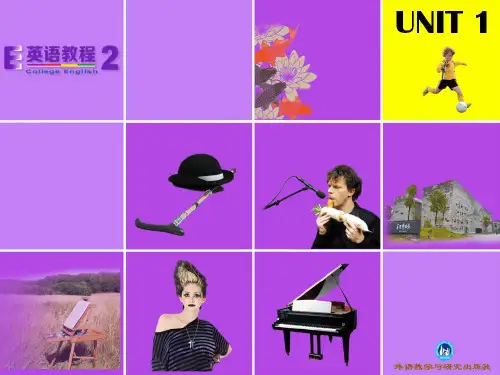
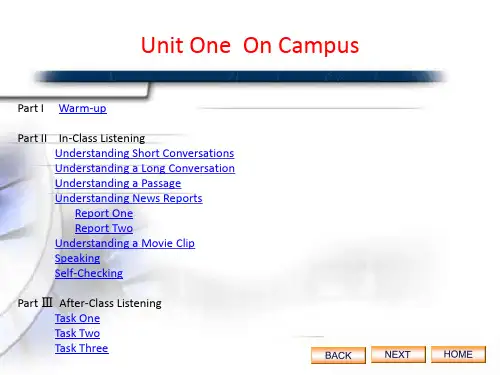
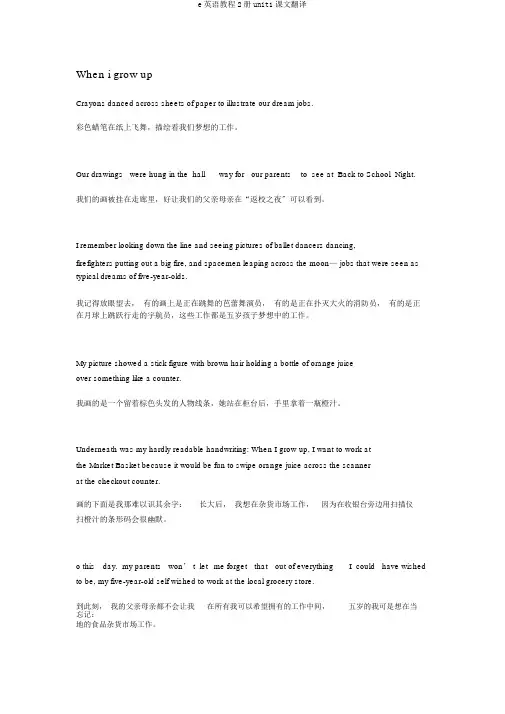
When i grow upCrayons danced across sheets of paper to illustrate our dream jobs.彩色蜡笔在纸上飞舞,描绘着我们梦想的工作。
Our drawings were hung in the hall way for our parents to see at Back to School Night.我们的画被挂在走廊里,好让我们的父亲母亲在“返校之夜〞可以看到。
I remember looking down the line and seeing pictures of ballet dancers dancing,firefighters putting out a big fire, and spacemen leaping across the moon— jobs that were seen as typical dreams of five-year-olds.我记得放眼望去,有的画上是正在跳舞的芭蕾舞演员,有的是正在扑灭大火的消防员,有的是正在月球上跳跃行走的宇航员,这些工作都是五岁孩子梦想中的工作。
My picture showed a stick figure with brown hair holding a bottle of orange juiceover something like a counter.我画的是一个留着棕色头发的人物线条,她站在柜台后,手里拿着一瓶橙汁。
Underneath was my hardly readable handwriting: When I grow up, I want to work atthe Market Basket because it would be fun to swipe orange juice across the scannerat the checkout counter.画的下面是我那难以识其余字:长大后,我想在杂货市场工作,因为在收银台旁边用扫描仪扫橙汁的条形码会很幽默。
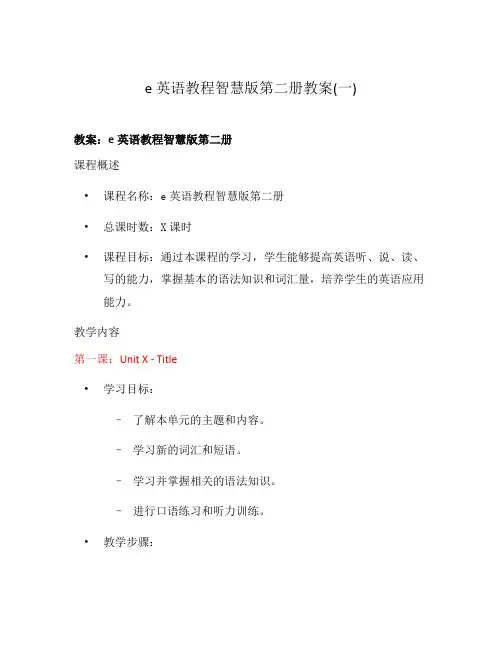
e英语教程智慧版第二册教案(一)教案:e英语教程智慧版第二册课程概述•课程名称:e英语教程智慧版第二册•总课时数:X课时•课程目标:通过本课程的学习,学生能够提高英语听、说、读、写的能力,掌握基本的语法知识和词汇量,培养学生的英语应用能力。
教学内容第一课:Unit X - Title•学习目标:–了解本单元的主题和内容。
–学习新的词汇和短语。
–学习并掌握相关的语法知识。
–进行口语练习和听力训练。
•教学步骤:1.引入新课:通过话题导入新的单元内容,激发学生学习兴趣。
2.学习词汇和短语:介绍本单元的重点词汇和短语,进行词义理解和例句展示。
3.学习语法知识:教授本单元相关的语法知识,通过例句和练习加深理解。
4.口语练习:组织学生进行口语练习,模拟真实情境,提高口语表达能力。
5.听力训练:进行听力练习,培养学生的听力理解能力。
6.课堂小结:对本节课的重点内容进行总结,并布置相关的课后作业。
第二课:Unit X - Title•学习目标:–复习上节课的内容。
–学习新的词汇和短语。
–继续学习相关的语法知识。
–进行阅读理解和写作练习。
•教学步骤:对知识点的记忆。
2.学习词汇和短语:介绍本单元的新词汇和短语,进行词义理解和例句展示。
3.学习语法知识:继续教授本单元相关的语法知识,通过例句和练习加深理解。
4.阅读理解:组织学生进行阅读理解练习,培养学生的阅读理解能力。
5.写作练习:引导学生进行写作练习,要求学生运用所学的语法知识和词汇进行写作。
6.课堂小结:对本节课的重点内容进行总结,并布置相关的课后作业。
第三课:Unit X - Title•学习目标:–复习上节课的内容。
–学习新的词汇和短语。
–继续学习相关的语法知识。
–进行听力和口语训练。
•教学步骤:对知识点的掌握程度。
2.学习词汇和短语:介绍本单元的新词汇和短语,进行词义理解和例句展示。
3.学习语法知识:继续教授本单元相关的语法知识,通过例句和练习加深理解。
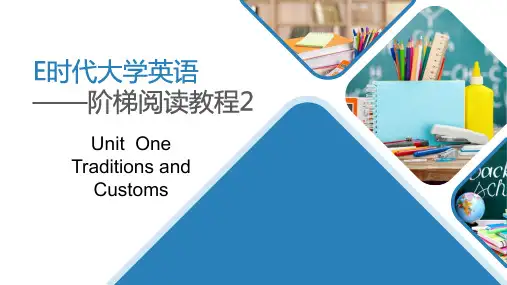
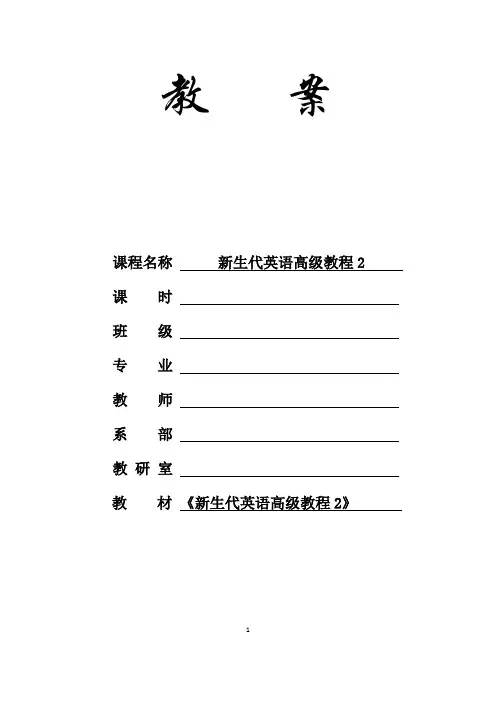
教案课程名称新生代英语高级教程2 课时班级专业教师系部教研室教材《新生代英语高级教程2》12345678910补充教学资源Vocabulary Builder参考译文蒂姆:嗨,希拉里。
这学期你的课程安排如何?希拉里:让我想想,课程表在这儿了。
看起来这学期会很忙。
周二和周四上午有数学课。
周一、周三和周五下午有物理课。
这两门是我的必修课,因为我学的是物理专业。
蒂姆:那选修课呢?你还有其他课程吗?希拉里:有,我有一门罗马史选修课,每周五上午上课。
你呢,蒂姆?你这学期的课程安排如何?蒂姆:简直让我抓狂!每天我都有英语课。
目前我还在上一门关于莎士比亚的课。
他是我最喜欢的作家。
这学期将会很忙。
希拉里:你说的一点儿没错。
Show Time参考译文桑切斯夫人:嗨,亲爱的。
学得怎么样?赫克托:说实话,妈妈,不怎么样。
桑切斯夫人:真的吗?出了什么问题?是漏掉了什么作业吗?赫克托:不是,妈妈。
问题在于这噪音。
噪音太大,我无法集中精力。
桑切斯夫人:哦,抱歉。
但你也知道你老爸,他觉得自己耳背,所以他总是把音量调到最大。
11赫克托:我知道。
只是这让我很难集中精力,仅此而已。
桑切斯夫人:好吧。
我们会尽量把声音调低。
维克托!把电视声音调小点。
你儿子正努力学习呢。
赫克托:喂?娜奥米:是你吗,赫克托?出什么事了?赫克托:没事,只是……刚刚我正在用功学习!娜奥米:好吧,打扰了!今天你过得肯定很糟吧。
赫克托:是的,可以这么说。
我不得不在我家厨房学习。
娜奥米:这是为什么?赫克托:我的父母!他们在看电视的时候喜欢把音量调得很大。
这让我很难集中精力。
娜奥米:听起来你需要一个更安静一点的地方学习。
赫克托:是的,你说的一点儿没错。
娜奥米:去图书馆学习怎么样?赫克托:这个想法不错。
但什么时候去?我的课程可是很多的!娜奥米:我也是。
就是因为这样合理安排时间才变得更加重要。
赫克托:你是怎么做到的?娜奥米:首先,我为自己制定了一个时间表。
赫克托:你做了个时间表写着你在什么时间去什么地点学习?娜奥米:是的,我真的是这么做的。
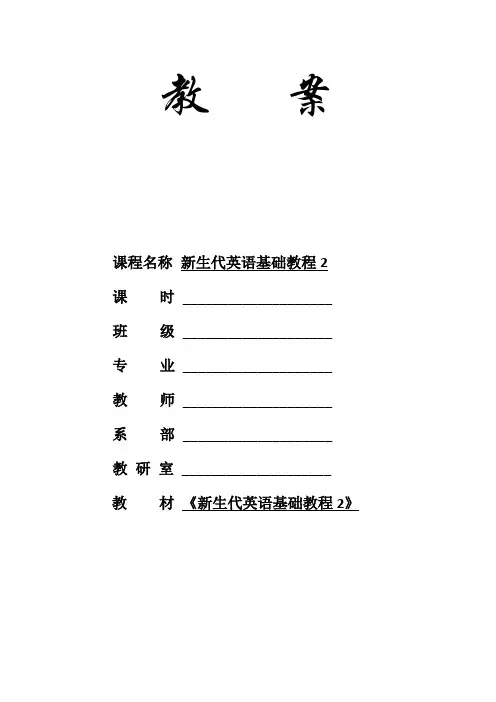
教案课程名称新生代英语基础教程2课时____________________班级____________________专业____________________教师____________________系部____________________教研室____________________教材《新生代英语基础教程2》FamilyShow Time“Where are you from”ReadingWhy is it called a honeymoonChat TimeThe rest is history.WritingFamily treeGrammarThe possessive ’sMy StoryFamilyHave students look at the picture and askthem to tell you as much as they canabout it.Then, go through the questions andcomplete each answer. In addition, youcan ask a few warm-up questions such as“How many people are in your family”Have the students listen and repeat the words. Use descriptive sentences to teach the family member words. For example, you can say “Your uncle is your mother or father’s brother.” “Your aunt is your mother or father’s sister.” “Your cousin is your uncle or aunt’s child,” and so on. A simple family drawn on the board can often help students to understand this.They may find it interesting to see your family tree, if you don’t min d sharing it with them.For the word frame, you can see that it is something we put around important pictures. You can then ask students if they have any framed photos in the class. You can also teach that we use the words married and single to describe s omeone’s relationship status. Ask “Have you been to a wedding recently” “Who got married”For Tell the students they will hear a conversation between a radio host and a celebrity (Anna). Now listen to the conversation and have students complete the sentences.Correct any mistakes. Have students talk about family members with sentencesthey have learnt.For Exercise D, let students match those Chinese kinship terms to the corresponding English definitions.First, have the students watch the video in its entirety. Ask basic comprehension questions such as, “Who are the main characters in this video” “Where are they” “What are they doing” “Why are they doing that” “How are they doing it”Next, have students take turns in explaining what is happening in each picture.Watch the video. Now look at Exercise B, and ask students to complete the True / False statements.Next, students can complete the dialogue in Exercise C. Have three students read out the dialogue with one student playing the role of Naomi, one as Hector and the other as Mrs. Sanchez. For an extension activity, you can also have the students redo the conversation using information from their family. Finally, have students match the questions to the answers in Exercise D.Review the vocabulary word honeymoon. Ask them to give you examples of where people might go on their honeymoon. Some students may even know where their parents went on honeymoon.Next, read and listen to the text and have the students read each of the True / False statements and choose the correctPut the students in pairs and have them practice talking about where they would like to go on honeymoon. Every two minutes have students stand up and change partners. Do this three or four times, depending on class size.Ask students to draw a poster and fill in some information. Ask students to introduce and advertise their dream honeymoon package to all classmates.Explain to students that they will hear a conversation in which Andrew tells Jenny about his wedding plans. Introduce the key vocabulary words for this conversation.Tell the students to listen carefully and write down what they hear in the blank spaces. If necessary, pause the recording so that students have time to write.Next, have students practice asking about families in pairs, monitoring them while they do so.Now, have students read through the Language Note, teaching the phrase “the rest is history.”For Exercise C, you can divide students into pairs, and ask them to act out the situation. They can take turns playingAsk students to look at the family tree and fill in the names and their occupations. Check their work.Ask students to write names and occupations of their family members as in the example. Remind them of the appropriate form of Chinese names. Have two volunteers write their answers on the board and check their spelling.Teach students to describe their family relations using the sentence pattern in Exercise C.Explain to students that we use the possessive s to describe who owns something. First, write a large ’s on the board. Next, tell the students that we add ’s for when one person owns something. Walk around the class, picking up students’ items and giving examples, such as “This is John’s book”, emphasizing the ’s. Have students echo you and then ask them to try on their own.Then, tell students that for two names, we add ’s to the second name only.After that, you will need to tell students about irregular plurals. Make examples using the most common irregular plurals used with ’s: children, men, women and people, etc.Let students complete the exercises, and then ask them to change books and go through the answers, correcting any mistakes.My Story To improvestudents’ listeningcomprehensionand speakingability through theuse of videoTell students that they will see a video in whichreal people talk about their families.Now, watch the video and have students completethe true or false statements. In some cases, youmay need to pause the video to help the students.Now, have students tell you the answers,correcting any mistakes. Watch the video againand have students write in the missing words,pausing the video if necessary. Check thestudents’ answers, correcting any mistakes.For the discussion section, start by going throughthe model answers in the book, and have studentsrepeat after you. Then, give the students youranswers to the questions. Next, you can haveseveral students give their answers to the class.Finally, have the students discuss the questions inpairs and/or in groups.课后学习设计作业Finish all the exercises in Unit 1.Read the text in this unit again and try tosummarise its content.Interview a family member and write a familydescription for him/her.课后总结与反思补充教学资源VOCABULARY BUILDER参考译文主持人:您正在收听的是诺维奇广播电台,我是主持人艾伦·彼得斯。
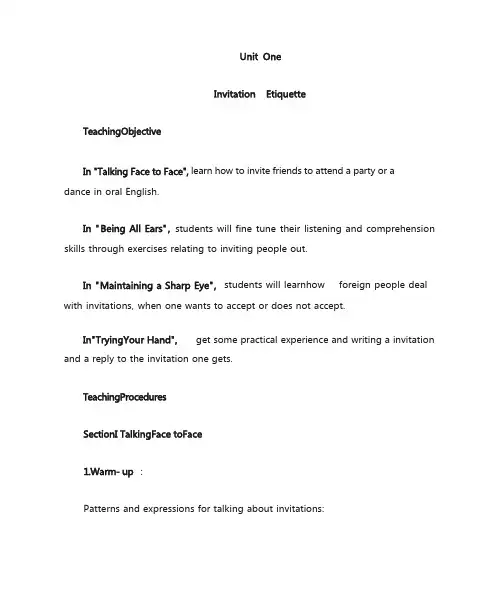
dance in oral English.students will fine tune their listening and comprehensionskills through exercises relating to inviting people out.with invitations, when one wants to accept or does not accept.and a reply to the invitation one gets.Patterns and expressions for talking about invitations:I’dliketoinviteyoutodinner.我想请你吃晚饭。
Why don’t you come and join us for disco?你为什么不和我们一起跳迪斯科?It’s very kind of you to invite me.谢谢你邀请我。
How nice of you! Many thanks.你真好!多谢。
I’dlove to. That wouldbe grea t.我很愿意去。
太好了!Oh, dear, I’m afraid I’m busy tonight. Perhaps tomorrow evening?哦,亲爱的,今晚我很忙。
明晚也许可以吧?Could you make it another time, perhaps next Sunday?你能改个时间吗,下个星期天怎样?It’s very kind of you, but you see I’ll have to prepare for my exam.非常感谢,可你知道我得准备考试。
I’m sorry I can’t, but thank you all the same.真抱歉,我不能去。
可还是要谢谢你。
Wouldyoulike to … ?您愿意…吗?I’dlike toinvite youto …我想邀请你参加…?I would like to know if you could come to …?我想知道你是否能来…May I invite you to …?敬请光临…Wouldit be possible tojoinus for… ?请问你是否能光临…?Would it be convenient to take part in …?请问你是否方便参加…?I was wondering if you would be interested in …?不知你是否有兴趣参加…?Thank you. I’ll be happy to come.谢谢.我很高兴接受你的邀请.I’dlove to. That wouldbe grea t.我很愿意去.太好了.Thank you for invitation.谢谢你的邀请.I’dbe gladtocom e.我很高兴前往.I’d love to, but I can’t come.我很想参加,但是不能来.Thank you for your invitation, but I don’t think I can make it.感谢你的邀请,但我恐怕不能赴约.Unfortunately,I’malready busy that day.很遗憾,我那天事情太多了.It’s very kind of you, but you see I’ll have to prepare for my exam.非常感谢,可你知道我得准备考试。
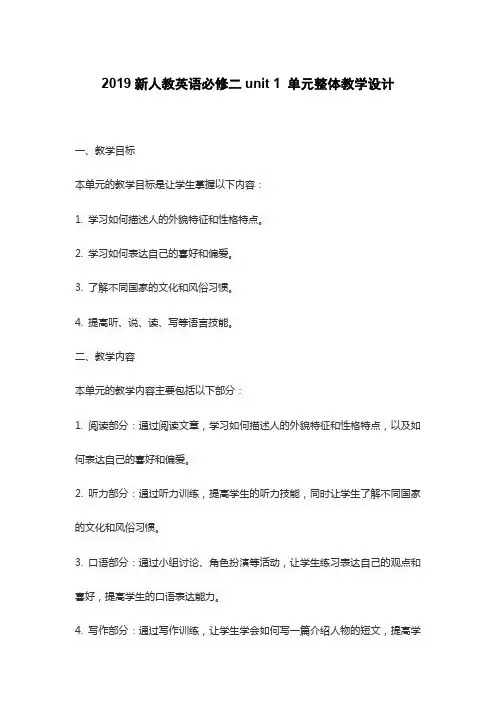
2019新人教英语必修二unit 1 单元整体教学设计
一、教学目标
本单元的教学目标是让学生掌握以下内容:
1. 学习如何描述人的外貌特征和性格特点。
2. 学习如何表达自己的喜好和偏爱。
3. 了解不同国家的文化和风俗习惯。
4. 提高听、说、读、写等语言技能。
二、教学内容
本单元的教学内容主要包括以下部分:
1. 阅读部分:通过阅读文章,学习如何描述人的外貌特征和性格特点,以及如何表达自己的喜好和偏爱。
2. 听力部分:通过听力训练,提高学生的听力技能,同时让学生了解不同国家的文化和风俗习惯。
3. 口语部分:通过小组讨论、角色扮演等活动,让学生练习表达自己的观点和喜好,提高学生的口语表达能力。
4. 写作部分:通过写作训练,让学生学会如何写一篇介绍人物的短文,提高学
生的写作技能。
三、教学难点与重点
本单元的教学难点与重点主要包括以下内容:
1. 重点:如何描述人的外貌特征和性格特点,以及如何表达自己的喜好和偏爱。
2. 难点:如何将所学知识运用到实际生活中,提高自己的语言运用能力。
四、教学步骤与安排
1. 导入:通过提问和讨论的方式,引导学生进入本单元的主题——人物介绍。
2. 阅读:让学生阅读文章,了解如何描述人的外貌特征和性格特点,以及如何表达自己的喜好和偏爱。
3. 听力:播放听力材料,让学生了解不同国家的文化和风俗习惯。
4. 口语:组织学生进行小组讨论、角色扮演等活动,练习表达自己的观点和喜好。
5. 写作:让学生根据所学知识,写一篇介绍人物的短文。
6. 总结:对本单元所学内容进行总结,同时布置作业。
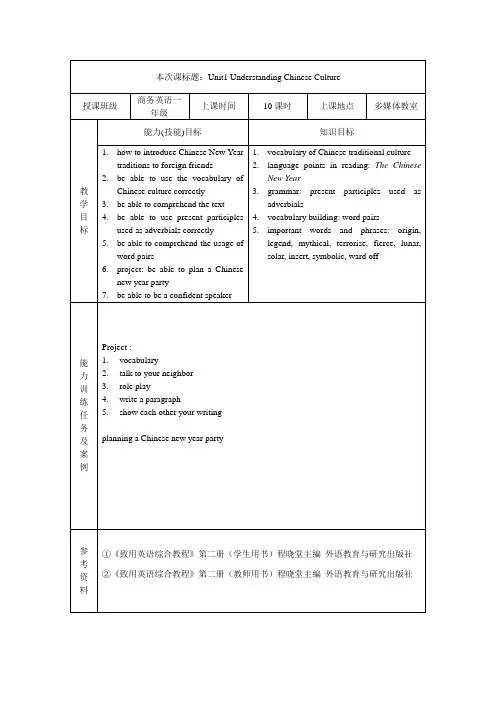
Section One Around the topicStep 1 Topic introduction:Many Chinese students find it very difficult to introduce Chinese culture to foreign friends.The biggest problem is that they don’t know how to express their understanding about Chinese culture or how to explain some typical concepts in Chinese culture. Chinese learners of English as a foreign language should not only study western cultures, but also deepen their understanding of Chinese culture, so that they can introduce it to the outside word.Step 2 Your ideasWork in groups or pairs and discuss the following questions1)Why is spring Festival so important for the Chinese people?2)What do you usually do during the Spring Festival3)Are there any special celebration activities in your hometown during Spring Festival?4)In what ways do you think the Spring Festival has Changed?How much do you know about the Chinese New Year?A.Which day in the 15-day celebration is for the sons-in-laws to pay a visit to theirparents-in-law?The third and fourth days.B. What is the fifth day called?Po Woo.C. How many kinds of traditional New Year food do you know?Dumplings, a whole fish, chicken, New Year cake…D. Do we use knives or scissors on New Year's Day?NO. They may cut off fortune.E. What fruit do we usually use as a decoration during the Spring Festival?Oranges and Tangerines. They are symbols for abundant happiness.Step 3 VocabularyThere are some special things about Spring Festival, which are difficult to translate into English. Here are some English words and expressions related to the Spring Festival. Try to get their meanings.Remind students that names of some typical Chinese things do not have exact equivalents in English. Ask them to guess the meaning of the English words and phrases related to theThe teacher can offer students a particular situation for students to practice in which students can give a brief talk with some of the words in the table above so that they can master a better usage of these words.Step 4 Listening and speakingAsk students to read the questions first. Then play the recording and encourage them to take notes while listening.1.Q: What are they talking about?A: They are talking about the Spring Festival.2.Q: How did Li Ming spend his holiday?A: Li Ming spent his holiday with his family in his hometown.3.Q: What is Susan curious about?A: Susan is curious about how Chinese people celebrating their Spring Festival.4.Q: What make the Spring Festival different from other holidays?A: Giving presents and staying with the family.5.Q: What do Chinese People do on the Eve of the Spring Festival according to the recording?A: In the past, all the members of a family would stay at home making dumplings together.Now many people enjoy watching TV. During the day, children wear their new clothes. The evening is usually spent playing games, talking, eating and drinking.Step 5 A quizDuring the Spring Festival, some things are believed to bring good luck for the new year, while other things might bring bad luck. Read the items in the table below and decide whether they bring good luck or bad luck. When you finish, compare your answers in pairs.This quiz is just for fun. Remind students that we should not be superstitious and the dos and don’ts during the Spring Festival are only parts of our traditions and customs. We should hold a right attitude towards them.Ask students to do the exercise first based on their own understanding and then compare their answers with their partners’. They may discuss them if necessary. When they finish, you may show and explain answers.Section Two ReadingThis section introduces the tradition of the Chinese New Year. By studying it, students will learn more about the legend of Nian and traditional Chinese New Year celebration activities. Most importantly, students will learn how to introduce the Chinese New Year to foreign friends.Step 1 Pre-reading tasksBefore you read, discuss the following questions in groups:1.Do you know why we call the Spring Festival “Nian”?2.Do you know why we Chinese celebrate the New Year at a different time from the Westernworld?Read the instruction as a class. Divide students into groups. Ask them to discuss the questions. Activate their prior knowledge of the Spring Festival and encourage them to share informationwith others. Pick some volunteers to answer these tow questions as representatives of their group. Step 2 Text illumination1)Ask several students to read the whole text in order to check whether they preview thetext and get a general understanding bout it or not beforehand.2)Ask students to summarize the text3)The teacher can put the comprehension check either before or after illuminating the textaccording to the needs of class and the students’ comprehension ability.4)Illuminate the text, during the process of which the teacher can encourage students tohighlight or underline the important parts when they read the text in detail. Try to explain that it can help students to grasp the important details and review important points Language points:1. legend n.story handed down from the past, especially one that may not be true 传奇,传说e.g. The legend of Robin Hood is well-known.2. mythical adj. existing only in an ancient story, imagined or invented 神话的,虚构的e.g. Qi Lin is a mythical Chinese creature which is similar to a unicorn.myth n. 神话e.g. ancient Greek myths3. terrorise v. to fill or overpower with terror, to terrify 使惊恐不安,恐吓e.g. The local gangs terrorised the neighborhood.4. fierce adj. violent and angry 凶猛的,凶狠的e.g. Swans are always fierce in defense of their young.The leopard looks fierce.5. lunar adj. determined or measured in reference to the moon 根据月亮决定或测定的e.g. The Chinese New Year falls on lunar January, 1st.6. solar adj. determined or measured in reference to the sun 根据太阳决定或测定的e.g. Solar energy is one kind of important energy nowadays.7. insert v. to put or set into, between, or among 插入,嵌入e.g. The editor inserted an advertisement in the newspaper.insert a key into a lock8. symbolic adj. representing a particular idea or quality 象征的,符号的e.g. The cross is symbolic of Christianity9. ward off to keep away (somebody/something that is dangerous or unpleasant) 挡开,避开e.g. He carried a gun to ward off possible attacks.Step 3 Post-reading exercises1.What is the significance of the following things during the Spring Festival?2.Discussion:Read the instruction as a class. Divide students into groups of four. Ask them to discuss these questions. Get feedback when they finish. Try to encourage them to express their opinions thoroughly in English.3.V ocabulary and structureThis part is about some vocabulary and structure exercises related to the text. Ask students to finish them independently beforehand. Check their answers in class. Try to encourage them to explain by themselves to check whether they fully understand the exercises or not. The teacher is supposed to give some explanations if necessary.A.Work out the meanings of the underlined words with the help of the context.B.Fill in the blanks with the words below. Change the form where necessary.plete each pair of the sentences with the correct form of the same verb, one as apresent participle (-ing) and the other as a past participle (-ed).4.WritingRead the instruction as a class. Leave the writing task as homework. Check their work next time.Write down your experience about the Spring Festival. The following questions may help you to come up with some ideas.1)How does your family prepare for the Spring Festival?2)What traditional activities does your family do to celebrate the Spring Festival?3)What special activity do you like most when you are celebrating the Spring Festival?Section Three language in use: present participles used as adverbialsStep 1 test your grammarThe aim of this practice is to make students aware of the present participles used as adverbials. Based on their study of the text, they may gain a deeper understanding by doing these exercises. Try to encourage students to explain by themselves through recalling and understanding of this grammatical phenomenon.Step 2 illumination and developmentBriefly explain the grammatical knowledge of participles. Then ask students to finish these exercises. Check their work when they finish.一、现在分词做状语(表原因,时间,条件,让步,行为方式,伴随状况)现在分词与主句的主语一致,且形成主谓关系,就是说现在分词的动作发出者是主句的主语。
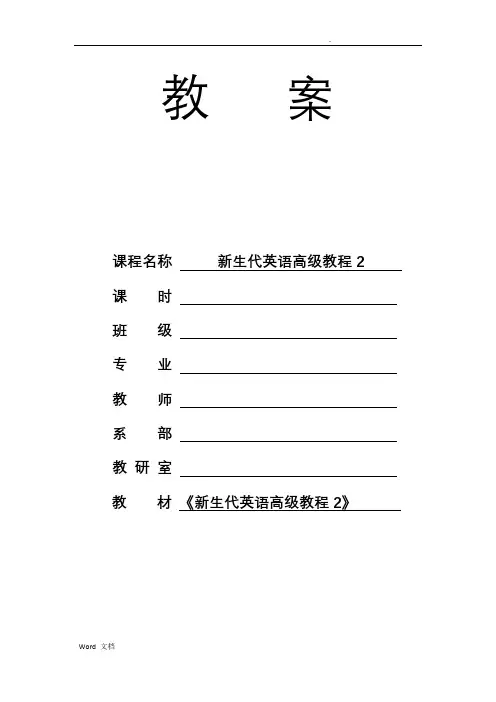
教案课程名称新生代英语高级教程2 课时班级专业教师系部教研室教材《新生代英语高级教程2》补充教学资源Vocabulary Builder参考译文蒂姆:嗨,希拉里。
这学期你的课程安排如?希拉里:让我想想,课程表在这儿了。
看起来这学期会很忙。
二和四上午有数学课。
一、三和五下午有物理课。
这两门是我的必修课,因为我学的是物理专业。
蒂姆:那选修课呢?你还有其他课程吗?希拉里:有,我有一门罗马史选修课,每五上午上课。
你呢,蒂姆?你这学期的课程安排如?蒂姆:简直让我抓狂!每天我都有英语课。
目前我还在上一门关于莎士比亚的课。
他是我最喜欢的作家。
这学期将会很忙。
希拉里:你说的一点儿没错。
Show Time参考译文桑切斯夫人:嗨,亲爱的。
学得怎么样?赫克托:说实话,妈妈,不怎么样。
桑切斯夫人:真的吗?出了什么问题?是漏掉了什么作业吗?赫克托:不是,妈妈。
问题在于这噪音。
噪音太大,我无法集中精力。
桑切斯夫人:哦,抱歉。
但你也知道你老爸,他觉得自己耳背,所以他总是把音量调到最大。
赫克托:我知道。
只是这让我很难集中精力,仅此而已。
桑切斯夫人:好吧。
我们会尽量把声音调低。
维克托!把电视声音调小点。
你儿子正努力学习呢。
赫克托:喂?娜奥米:是你吗,赫克托?出什么事了?赫克托:没事,只是……刚刚我正在用功学习!娜奥米:好吧,打扰了!今天你过得肯定很糟吧。
赫克托:是的,可以这么说。
我不得不在我家厨房学习。
娜奥米:这是为什么?赫克托:我的父母!他们在看电视的时候喜欢把音量调得很大。
这让我很难集中精力。
娜奥米:听起来你需要一个更安静一点的地学习。
赫克托:是的,你说的一点儿没错。
娜奥米:去图书馆学习怎么样?赫克托:这个想法不错。
但什么时候去?我的课程可是很多的!娜奥米:我也是。
就是因为这样合理安排时间才变得更加重要。
赫克托:你是怎么做到的?娜奥米:首先,我为自己制定了一个时间表。
赫克托:你做了个时间表写着你在什么时间去什么地点学习?娜奥米:是的,我真的是这么做的。
When i grow upCrayons danced across sheets of paper to illustrate our dream jobs.彩色蜡笔在纸上飞舞,描绘着我们梦想的工作。
Our drawings were hung in the hall way for our parents to see at Back to School Night.我们的画被挂在走廊里,好让我们的父母在“返校之夜”可以看到。
I remember looking down the line and seeing pictures of ballet dancers dancing, firefighters putting out a big fire, and spacemen leaping across the moon—jobs that were seen as typical dreams of five-year-olds.我记得放眼望去,有的画上是正在跳舞的芭蕾舞演员,有的是正在扑灭大火的消防员,有的是正在月球上跳跃行走的宇航员,这些工作都是五岁孩子梦想中的工作。
My picture showed a stick figure with brown hair holding a bottle of orange juice over something like a counter.我画的是一个留着棕色头发的人物线条,她站在柜台后,手里拿着一瓶橙汁。
Underneath was my hardly readable handwriting: When I grow up, I want to work at the Market Basket because it would be fun to swipe orange juice across the scanner at the checkout counter.画的下面是我那难以辨认的字:长大后,我想在杂货市场工作,因为在收银台旁边用扫描仪扫橙汁的条形码会很有趣。
Unit 1 Invitation EtiquetteUnit GoalsWhat you should learn to doMake an oral invitation to:Invite people to join daily activitiesInvite people to formal occasionsMake a written invitation(write an invitation card or a letter) for:Personal invitationOfficial occasionsGive a reply to:An oral invitationA written invitationWhat you should know aboutInvitation culture: western and ChineseWord order in a subordinate clauseRequirements:After learning this unit, students should grasp:1.Read and understand the meaning of invitation cards and letters2.How to write invitation cards and letters and remember the patterns of invitation cards and letters3.How to invite people to party or dinner, and how to accept and decline invitations4.The customs of inviting people in different countries5.Important words, phrases and language points in the passageIn our daily life, we need to invite others to dinner or take part in all kinds of parties, so we should know about western custom about invitation.Foreign custom is much stricter than Chinese custom in the matter of replying toinvitations. When you receive an invitation you should answer is immediately, saying definitely whether you are able to accept it or not.If the invitation is given by word of mouth, in conversation or at a chance meeting, you should answer at once whether you can come or not. If you cannot give an answer at that time, you may say “May I let you know this evening” or some such words.By studying this unit, we will know about how to invite the others, how to accept or decline the invitation, and how to write invitation cards/letters.Section I Talking Face to Face1.Imitating Mini-Talks2.Acting out the Tasks3.Studying Email Information on the Internet4.Following Sample Dialogues5.Putting Language to UseSection II Being All Ears1.Learning Sentences for Workplace Communication2.Handling a Dialogue3.Understanding a Short Speech / TalkSection III Trying your Hand1.Practicing Applied Writing2.Writing Sentences and Reviewing GrammarSection IV Maintaining a Sharp EyePassage 1 :Information Related to the Reading PassageWhether it is to a wedding, a dinner party, shower or gala event, an invitation comes with some important obligations. Here’s a quick guide to keep you on the guest list.1. R.S.V.PFrom the French “Répondez, s’il vous plait”, it means “Please reply.”Thislittle code has been around for a long time and it’s definitely telling you that your hosts want to know if you are attending. Reply promptly, within a day or two of receiving an invitation.2. How do I respond? Reply in the manner indicated on the invitation.R.S.V.P and no response card: a handwritten response to the host at the return address on the envelope.Response Card: fill in and reply by the date indicated and return in the enclosed envelope.R.S.V.P with phone number: telephone and make sure to speak in person —answering machines can be unreliable.R.S.V.P with e-mail: you may accept or decline electronically.Regrets only: reply only if you cannot attend. If your host doesn’t hear from you, he is expecting you!No reply requested? Unusual, but it is always polite to let someone know your intentions. A phone call would be sufficient.3. Is that your final answer?Changing a “yes”to a “no”is only acceptable on account of: illness or injury, a death in the family or an unavoidable professional or business conflict. Call your hosts immediately.Canceling because you have a “better”offer is a surefire way to get dropped from ALL the guest lists.Being a “no show”is unacceptable.Changing a “no”to a “yes”is OK only if it will not upset the hosts’arrangements.4. “May I bring …?”Don’t even ask! An invitation is extended to the people the hosts want to invite —and no one else.…a date. Some invitations indicate that you may invite a guest or date (Mr. JohnEvans and Guest) and when you reply, you should indicate whether you are bringing someone, and convey their name.…my children. If they were invited, the invitation would have said so.…my houseguest. It’s best to decline the invitation, stating the reason. This gives your host the option to extend the invitation to your guests, or not.5. Say “Thank You.”Make sure to thank your hosts before you leave, and then again by phoneor note the next day.Text Business InvitationA case of mistaken identity!Don’t worry, we’ve been assured that this mystery will besolved in time for ourHoliday Office PartyWe’re leaving the investigation to those who do it best.Let’s get away from all those computers, papers and mess and cometo our office party in your best suit or dress.Come join us and Toast the SeasonThursday, December 9th 2010 5:00 P.M.The Columbia House –Penthouse Floor 485 Jefferson PlazaLeonard, Barley, Travis, Bailey and SmithRegrets only to Dianne 248-8522It would be a crime to miss our party or not be on time485 Jefferson PlazaBusiness invitations can be informal or formal. Although invitations are usually sent through the mail, informal invitations such as e-mail and phone invitations are becoming more acceptable.Invitation TimingFor most formal occasions, it’s best to invite guests three or four weeks inadvance. If you choose to invite your guests by phone, remind them again in writing two weeks before the gathering. Here are a few guidelines for your information:●Six to eight months before an important seminar to which out-of-town executives are invited.●Four weeks before an evening reception.●Two to four weeks before a cocktail party.Invitation FormatFormal business invitations are most commonly printed on white or off-white high-quality paper. A company can use any color of paper it desires, as long as it upholds and promotes the company’s image.With preprinted invitations, you simply fill in the blanks to tell what, where, and when the party will be and who is giving it. It’s also acceptable to include an RSVP notation and your phone number or address on the invitation for more accurate planning.Responding to an InvitationEither use the address or phone number printed in the lower left corner of the invitation or return the RSVP card sent with the invitation. If a “Please reply by”a given date is included in the invitation, be polite enough to reply by that date. If the words “Regrets only”are printed in the lower left corner of the invitation, you need only to inform the host if you will not be able to attend. If your host does not hear from you, you are expected to attend.Never ask to bring a guest unless the invitation states “Mr. Louis Winthorp and Guest.”Most likely, the host will have only enough food and drinks for the number of people he invites. Showing up with an uninvited friend could turn out to be an embarrassing situation for everyone.Language Points1 Explanation of Difficult Sentences1. (Para. 1) Although invitations are usually sent through the mail, informalinvitations such as e-mails and phone invitations are becoming more acceptable. Analysis: such as means “of the same kind, like”and should be followed by nouns or noun phrases.Translation: 虽然邀请函通常通过信函方式发出,但目前像电子邮件、电话邀请等非正式邀请越来越被普遍使用。